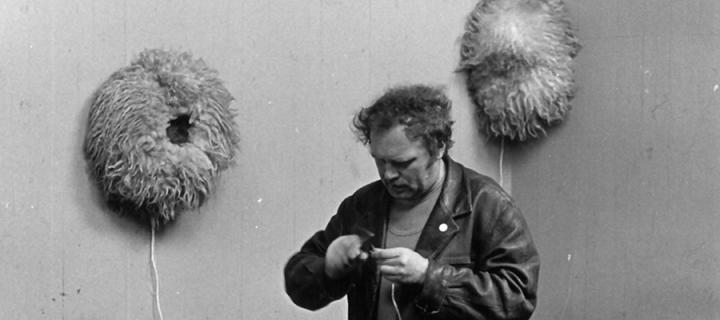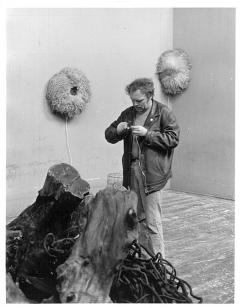24. Günter Weseler rigging up his Breathing Objects (1970) in studio E.11
Visitors to Strategy: Get Arts really enjoyed Günter Weseler’s Breathing Objects (1970), a dramatic installation of hairy indefinable creatures which shook on tables, on the wall, or inside cots.

Günter Weseler (1930-2020) grew up in Allenstein [Olsztyn] in East Prussia [now Poland].
As a 15 year old he was asked to build anti-tank traps against the Red Army in the last days of the Second World War.
Before turning to study art he completed an apprenticeship as a sound engineer, developing a technical understanding of small machinery which would serve him well in his artistic practice later on.
He moved to Düsseldorf in 1962 where he became friends with Daniel Spoerri. Weseler was interested in acoustic as well as visual expression.
From 1962 to 1963 he developed his ‘Atmen für Töne’ (Breaths as Sounds), and his ‘Atemmusik’ (Breath Music). The rhythmic element of breathing would determine the musical sequence.
Breathing Objects

Weseler moved from creating ‘Atemmusik’ to ‘Atemobjecke’ (Breathing Objects) in 1966 and these were to be seen in Edinburgh in 1970.
These objects initially ‘breathed’ courtesy of a VW windscreen wiper motor (the utilisation of VW here providing an interesting connection to Beuys’s The Pack). The effect was mesmerising.
At Strategy: Get Arts, Weseler presented a bizarre evening meal on a table of fluffy rex rabbits in clay bowls all accompanied by a recording of the sound of cicadas.
This formed a counterpart to Spoerri’s Banana Trap Dinner staged in the ECA main boardroom. The two artists had already collaborated in Düsseldorf on Spoerri’s experimental ‘Eat Art’ project.
In ECA studio space (E.11), Weseler created a dramatic installation of hairy indefinable creatures, a ‘new species’ almost looking like dismembered bits of Highland Cattle, in cots, cages, or attached to walls, as well as on a table, all rigged up in such a way that they appeared to be alive.
Weseler is considered to be one of the most important artists of the 1960s Düsseldorf art scene. He continued making his breathing objects for fifty years and gained international recognition for this achievement even though he was a fairly reclusive artist.
His ‘breathing objects’ continue to be shown, most recently at the Galleria Allegra Ravizza in Lugano, Switzerland (6 March – 3 April 2020).
Imi Knoebel
In addition to Weseler, the work of Imi Knoebel (b. 1940 in Dessau) could also be seen in studio E.11.
Knoebel moved to the Kunstakademie Düsseldorf in 1964 and was taken on by Joseph Beuys, becoming one of his first students to use photography as an independent artistic medium.
Whilst in Düsseldorf, Knoebel became interested in projection technologies. Key figures of the ZERO group were among the first to use projectors.
Already in the late 1950s, Otto Piene had created artworks from light projected through punctured surfaces. Knoebel followed Piene in using projectors. For his Innenprojektionen (1968–1970) he started using carousel slide projections, creating empty squares of light, projected on a wall or in a darkened, closed-off room.
Alternatively, he would mark the blank photographic slides with ink to create minimalist geometric projections, in effect abstract painting with light. Knoebel is one of Germany’s leading artists, known beyond his light projections for his minimalist abstract painting and sculpture, particularly his Messerschnitt (knife cut) paintings.
In June 2011, his six stained glass panes were unveiled within the apse of Notre-Dame de Reims Cathedral, a gesture of reconciliation by the artist.
C.W.


